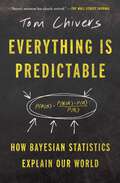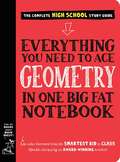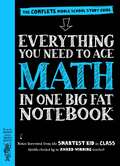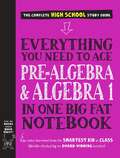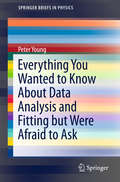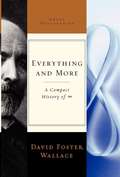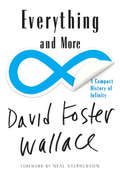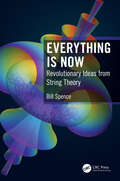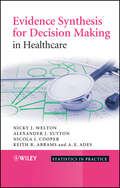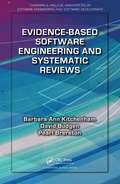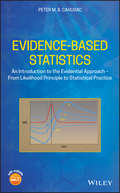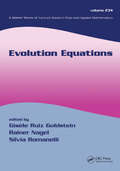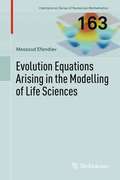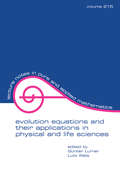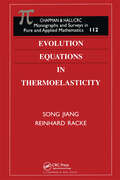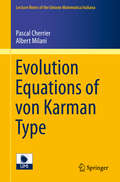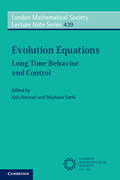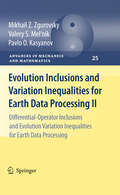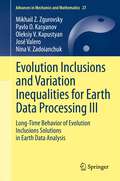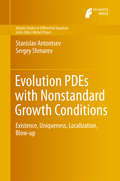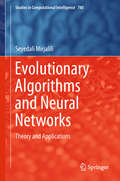- Table View
- List View
Everything I Need to Know Before I'm Five
by Valorie FisherDo you know your letters? Can you count to twenty? Learn all that and more in this all-in-one concept picture book. Perfect for kids heading to kindergarten, this book covers the alphabet, counting, opposites, shapes, colors, and seasons. Award winning author-illustrator Valorie Fisher uses bright, gorgeous photos of retro toys to illustrate these topics in a completely fresh way. Parents will love this stylish and funny approach to basic concepts, while kids will learn, well, everything.From the Hardcover edition.
Everything Is Predictable: How Bayes' Remarkable Theorem Explains the World
by Tom ChiversThomas Bayes was an eighteenth-century Presbyterian minister and amateur mathematician whose obscure life belied the profound impact of his work. Like most research into probability at the time, his theorem was mainly seen as relevant to games of chance, like dice and cards. But its implications soon became clear. Bayes' theorem helps explain why highly accurate screening tests can lead to false positives, causing unnecessary anxiety for patients. A failure to account for it in court has put innocent people in jail. But its influence goes far beyond practical applications. A cornerstone of rational thought, Bayesian principles are used in modelling and forecasting. 'Superforecasters', a group of expert predictors who outperform CIA analysts, use a Bayesian approach. And many argue that Bayes' theorem is not just a useful tool, but a description of almost everything - that it is the underlying architecture of rationality, and of the human brain. Fusing biography, razor-sharp science communication and intellectual history, Everything Is Predictable is a captivating tour of Bayes' theorem and its impact on modern life. From medical testing to artificial intelligence, Tom Chivers shows how a single compelling idea can have far-reaching consequences.
Everything Is Predictable: How Bayesian Statistics Explain Our World
by Tom ChiversA captivating and user-friendly tour of Bayes&’s theorem and its global impact on modern life from the acclaimed science writer and author of The Rationalist&’s Guide to the Galaxy.At its simplest, Bayes&’s theorem describes the probability of an event, based on prior knowledge of conditions that might be related to the event. But in Everything Is Predictable, Tom Chivers lays out how it affects every aspect of our lives. He explains why highly accurate screening tests can lead to false positives and how a failure to account for it in court has put innocent people in jail. A cornerstone of rational thought, many argue that Bayes&’s theorem is a description of almost everything. But who was the man who lent his name to this theorem? How did an 18th-century Presbyterian minister and amateur mathematician uncover a theorem that would affect fields as diverse as medicine, law, and artificial intelligence? Fusing biography, razor-sharp science writing, and intellectual history, Everything Is Predictable is an entertaining tour of Bayes&’s theorem and its impact on modern life, showing how a single compelling idea can have far reaching consequences.
Everything You Need to Ace Geometry in One Big Fat Notebook (Big Fat Notebooks Series)
by Workman Publishing Christy NeedhamThis Big Fat Notebook covers everything you need to know during a year of high school geometry class, breaking down one big bad subject into accessible units. Learn to study better and get better grades using mnemonic devices, definitions, diagrams, educational doodles, and quizzes to recap it all.
Everything You Need to Ace Math in One Big Fat Notebook: The Complete Middle School Study Guide (Big Fat Notebooks Series)
by Workman Publishing Altair Peterson Editors of Brain Quest Ouida NewtonIt’s the revolutionary math study guide just for middle school students from the brains behind Brain Quest. <p><p> Everything You Need to Ace Math . . . covers everything to get a student over any math hump: fractions, decimals, and how to multiply and divide them; ratios, proportions, and percentages; geometry; statistics and probability; expressions and equations; and the coordinate plane and functions. <p><p> The BIG FAT NOTEBOOK™ series is built on a simple and irresistible conceit—borrowing the notes from the smartest kid in class. There are five books in all, and each is the only book you need for each main subject taught in middle school: Math, Science, American History, English Language Arts, and World History. Inside the reader will find every subject’s key concepts, easily digested and summarized: Critical ideas highlighted in neon colors. Definitions explained. Doodles that illuminate tricky concepts in marker. Mnemonics for memorable shortcuts. And quizzes to recap it all. <p><p> The BIG FAT NOTEBOOKS meet Common Core State Standards, Next Generation Science Standards, and state history standards, and are vetted by National and State Teacher of the Year Award–winning teachers. They make learning fun and are the perfect next step for every kid who grew up on Brain Quest.
Everything You Need to Ace Pre-Algebra and Algebra I in One Big Fat Notebook (Big Fat Notebooks Series)
by Jason Wang Workman PublishingPre-Algebra & Algebra 1? No Problem! The BIG FAT NOTEBOOK covers everything you need to know during a year of Pre-Algebra and Algebra 1 class, breaking down one big fat subject into accessible units, including: the number system, ratios, and proportions, scientific notation, introduction and equations, functions, graphing a line, square roots and cube roots, polynomial operations, quadratic functions, and more. <p> Study better with: <p> -Mnemonic devices <p>-Definitions <p>-Diagrams <p>-Educational doodles <p>-Quizzes to recap it all and get better grades
Everything You Wanted to Know About Data Analysis and Fitting but Were Afraid to Ask
by Peter YoungThese notes describe how to average and fit numerical data that have been obtained either by simulation or measurement. Following an introduction on how to estimate various average values, they discuss how to determine error bars on those estimates, and how to proceed for combinations of measured values. Techniques for fitting data to a given set of models will be described in the second part of these notes. This primer equips readers to properly derive the results covered, presenting the content in a style suitable for a physics audience. It also includes scripts in python, perl and gnuplot for performing a number of tasks in data analysis and fitting, thereby providing readers with a useful reference guide.
Everything and More: A Compact History of Infinity
by David Foster WallaceDavid Wallace brings his intellectual ambition to the story of how mathematicians have understood the infinite, from the ancient Greeks to the nineteenth-century mathematical genius Cantor's discovery that there is more than one kind of infinity.
Everything and More: A Compact History of Infinity
by Neal Stephenson David Foster Wallace"A gripping guide to the modern taming of the infinite."--The New York Times. With a new introduction by Neal Stephenson. Is infinity a valid mathematical property or a meaningless abstraction? David Foster Wallace brings his intellectual ambition and characteristic bravura style to the story of how mathematicians have struggled to understand the infinite, from the ancient Greeks to the nineteenth-century mathematical genius Georg Cantor's counterintuitive discovery that there was more than one kind of infinity. Smart, challenging, and thoroughly rewarding, Wallace's tour de force brings immediate and high-profile recognition to the bizarre and fascinating world of higher mathematics.
Everything is Now: Revolutionary Ideas from String Theory
by Bill SpenceThis engaging and beautifully written book gives an authoritative but accessible account of some of the most exciting and unexpected recent developments in theoretical physics. – Professor Lionel J Mason, Mathematical Institute, University of Oxford String theory is often paraded as a theory of everything, but there are a large number of untold stories in which string theory gives us insight into other areas of physics. Here, Bill Spence does an excellent job of explaining the deep connections between string theory, particle physics, and the novel way of viewing space and time. – Professor David Tong, Department of Applied Mathematics and Theoretical Physics, University of Cambridge Foremost amongst Nature’s closest-guarded secrets is how to unite Einstein’s theory of gravity with quantum theory – thereby creating a ‘quantum space-time’. This problem has been unsolved now for more than a century, with the standard methods of physics making little headway. It is clear that much more radical ideas are needed, and our front-line researchers are showing that string theory provides these. This book describes these extraordinary developments, which are helping us to think in entirely new ways about how physical reality may be structured at its deepest level. Amongst these ideas are that Everything can happen at the same time – it is all Now; Hidden spaces, large and small, are everywhere amongst us; The basic objects are ‘membranes’ that behave like soap bubbles and can explore the shape of spacetime in new ways; We are holographic projections from higher dimensions; You can take the ‘square root’ of gravity; Ideas from the ancient Greeks are resurfacing in a beautiful new form; And the very latest work shows that ‘staying positive’ is essential. The book is aimed at a general audience, using analogies, diagrams, and simple examples throughout. It is intended as a brief tour, enabling the reader to become aware of the main ideas and recent work. A full list of further resources is supplied. Bill Spence is the founding Director of the Centre for Research in String Theory at Queen Mary University of London. He has worked on string theory for over three decades.
Evidence Synthesis for Decision Making in Healthcare
by A. E. Ades Nicky J. Welton Keith R. Abrams Alexander J. Sutton Nicola J. CooperIn the evaluation of healthcare, rigorous methods of quantitative assessment are necessary to establish interventions that are both effective and cost-effective. Usually a single study will not fully address these issues and it is desirable to synthesize evidence from multiple sources. This book aims to provide a practical guide to evidence synthesis for the purpose of decision making, starting with a simple single parameter model, where all studies estimate the same quantity (pairwise meta-analysis) and progressing to more complex multi-parameter structures (including meta-regression, mixed treatment comparisons, Markov models of disease progression, and epidemiology models). A comprehensive, coherent framework is adopted and estimated using Bayesian methods.Key features:A coherent approach to evidence synthesis from multiple sources.Focus is given to Bayesian methods for evidence synthesis that can be integrated within cost-effectiveness analyses in a probabilistic framework using Markov Chain Monte Carlo simulation.Provides methods to statistically combine evidence from a range of evidence structures.Emphasizes the importance of model critique and checking for evidence consistency.Presents numerous worked examples, exercises and solutions drawn from a variety of medical disciplines throughout the book.WinBUGS code is provided for all examples. Evidence Synthesis for Decision Making in Healthcare is intended for health economists, decision modelers, statisticians and others involved in evidence synthesis, health technology assessment, and economic evaluation of health technologies.
Evidence-Based Software Engineering and Systematic Reviews (Chapman & Hall/CRC Innovations in Software Engineering and Software Development Series)
by Barbara Ann Kitchenham David Budgen Pearl BreretonIn the decade since the idea of adapting the evidence-based paradigm for software engineering was first proposed, it has become a major tool of empirical software engineering. Evidence-Based Software Engineering and Systematic Reviews provides a clear introduction to the use of an evidence-based model for software engineering research and practice.
Evidence-Based Statistics: An Introduction to the Evidential Approach - from Likelihood Principle to Statistical Practice
by Peter M. CahusacEvidence-Based Statistics: An Introduction to the Evidential Approach – from Likelihood Principle to Statistical Practice provides readers with a comprehensive and thorough guide to the evidential approach in statistics. The approach uses likelihood ratios, rather than the probabilities used by other statistical inference approaches. The evidential approach is conceptually easier to grasp, and the calculations more straightforward to perform. This book explains how to express data in terms of the strength of statistical evidence for competing hypotheses. The evidential approach is currently underused, despite its mathematical precision and statistical validity. Evidence-Based Statistics is an accessible and practical text filled with examples, illustrations and exercises. Additionally, the companion website complements and expands on the information contained in the book. While the evidential approach is unlikely to replace probability-based methods of statistical inference, it provides a useful addition to any statistician’s “bag of tricks.” In this book: It explains how to calculate statistical evidence for commonly used analyses, in a step-by-step fashion Analyses include: t tests, ANOVA (one-way, factorial, between- and within-participants, mixed), categorical analyses (binomial, Poisson, McNemar, rate ratio, odds ratio, data that’s ‘too good to be true’, multi-way tables), correlation, regression and nonparametric analyses (one sample, related samples, independent samples, multiple independent samples, permutation and bootstraps) Equations are given for all analyses, and R statistical code provided for many of the analyses Sample size calculations for evidential probabilities of misleading and weak evidence are explained Useful techniques, like Matthews’s critical prior interval, Goodman’s Bayes factor, and Armitage’s stopping rule are described Recommended for undergraduate and graduate students in any field that relies heavily on statistical analysis, as well as active researchers and professionals in those fields, Evidence-Based Statistics: An Introduction to the Evidential Approach – from Likelihood Principle to Statistical Practice belongs on the bookshelf of anyone who wants to amplify and empower their approach to statistical analysis.
Evolution Equations (Lecture Notes in Pure and Applied Mathematics #Vol. 234)
by Rainer Nagel Gisèle Ruiz Goldstein Silvia RomanelliCelebrating the work of renowned mathematician Jerome A. Goldstein, this reference compiles original research on the theory and application of evolution equations to stochastics, physics, engineering, biology, and finance. The text explores a wide range of topics in linear and nonlinear semigroup theory, operator theory, functional analysis, and li
Evolution Equations Arising in the Modelling of Life Sciences
by Messoud EfendievThis book deals with the modeling, analysis and simulation of problems arising in the life sciences, and especially in biological processes. The models and findings presented result from intensive discussions with microbiologists, doctors and medical staff, physicists, chemists and industrial engineers and are based on experimental data. They lead to a new class of degenerate density-dependent nonlinear reaction-diffusion convective equations that simultaneously comprise two kinds of degeneracy: porous-medium and fast-diffusion type degeneracy. To date, this class is still not clearly understood in the mathematical literature and thus especially interesting. The author both derives realistic life science models and their above-mentioned governing equations of the degenerate types and systematically studies these classes of equations. In each concrete case well-posedness, the dependence of solutions on boundary conditions reflecting some properties of the environment, and the large-time behavior of solutions are investigated and in some instances also studied numerically.
Evolution Equations Arising in the Modelling of Life Sciences (International Series of Numerical Mathematics #163)
by Messoud EfendievThis book deals with the modeling, analysis and simulation of problems arising in the life sciences, and especially in biological processes. The models and findings presented result from intensive discussions with microbiologists, doctors and medical staff, physicists, chemists and industrial engineers and are based on experimental data. They lead to a new class of degenerate density-dependent nonlinear reaction-diffusion convective equations that simultaneously comprise two kinds of degeneracy: porous-medium and fast-diffusion type degeneracy. To date, this class is still not clearly understood in the mathematical literature and thus especially interesting. The author both derives realistic life science models and their above-mentioned governing equations of the degenerate types and systematically studies these classes of equations. In each concrete case well-posedness, the dependence of solutions on boundary conditions reflecting some properties of the environment, and the large-time behavior of solutions are investigated and in some instances also studied numerically.
Evolution Equations and Their Applications in Physical and Life Sciences: Proceedings Of The Bad Herrenalb (karlsruhe), Germany, Conference (Lecture Notes in Pure and Applied Mathematics)
by G LumerThis volume presents a collection of lectures on linear partial differntial equations and semigroups, nonlinear equations, stochastic evolutionary processes, and evolution problems from physics, engineering and mathematical biology. The contributions come from the 6th International Conference on Evolution Equations and Their Applications in Physica
Evolution Equations in Thermoelasticity (Monographs and Surveys in Pure and Applied Mathematics)
by Reinhard Racke Song JiangAlthough the study of classical thermoelasticity has provided information on linear systems, only recently have results on the asymptotic behavior completed our basic understanding of the generic behavior of solutions. Through systematic work that began in the 80s, we now also understand the basic features of nonlinear systems. Yet some questions r
Evolution Equations of von Karman Type
by Pascal Cherrier Albert MilaniIn these notes we consider two kinds of nonlinear evolution problems of von Karman type on Euclidean spaces of arbitrary even dimension. Each of these problems consists of a system that results from the coupling of two highly nonlinear partial differential equations, one hyperbolic or parabolic and the other elliptic. These systems take their name from a formal analogy with the von Karman equations in the theory of elasticity in two dimensional space. We establish local (respectively global) results for strong (resp. , weak) solutions of these problems and corresponding well-posedness results in the Hadamard sense. Results are found by obtaining regularity estimates on solutions which are limits of a suitable Galerkin approximation scheme. The book is intended as a pedagogical introduction to a number of meaningful application of classical methods in nonlinear Partial Differential Equations of Evolution. The material is self-contained and most proofs are given in full detail. The interested reader will gain a deeper insight into the power of nontrivial a priori estimate methods in the qualitative study of nonlinear differential equations.
Evolution Equations: Long Time Behavior and Control (London Mathematical Society Lecture Note Series #439)
by Kaïs Ammari Stéphane GerbiThe proceedings of the summer school held at the Université Savoie Mont Blanc, France, 'Mathematics in Savoie 2015', whose theme was long time behavior and control of evolution equations. The event was attended by world-leading researchers from the community of control theory, as well as young researchers from around the globe. This volume contains surveys of active research topics, along with original research papers containing exciting new results on the behavior of evolution equations. It will therefore benefit both graduate students and researchers. Key topics include the recent view on the controllability of parabolic systems that permits the reader to overview the moment method for parabolic equations, as well as numerical stabilization and control of partial differential equations. Discusses the state of the art in control theory and evolution equations. Accessible to researchers and graduate students Authors include internationally renowned researchers in the area of control theory.
Evolution Inclusions and Variation Inequalities for Earth Data Processing I
by Valery S. Mel'Nik Mikhail Z. Zgurovsky Pavlo O. KasyanovHere, the authors present modern mathematical methods to solve problems of differential-operator inclusions and evolution variation inequalities which may occur in fields such as geophysics, aerohydrodynamics, or fluid dynamics. For the first time, they describe the detailed generalization of various approaches to the analysis of fundamentally nonlinear models and provide a toolbox of mathematical equations. These new mathematical methods can be applied to a broad spectrum of problems. Examples of these are phase changes, diffusion of electromagnetic, acoustic, vibro-, hydro- and seismoacoustic waves, or quantum mechanical effects. This is the first of two volumes dealing with the subject.
Evolution Inclusions and Variation Inequalities for Earth Data Processing III
by Mikhail Z. Zgurovsky Pavlo O. Kasyanov José Valero Nina V. Zadoianchuk Oleksiy V. KapustyanIn this sequel to two earlier volumes, the authors now focus on the long-time behavior of evolution inclusions, based on the theory of extremal solutions to differential-operator problems. This approach is used to solve problems in climate research, geophysics, aerohydrodynamics, chemical kinetics or fluid dynamics. As in the previous volumes, the authors present a toolbox of mathematical equations. The book is based on seminars and lecture courses on multi-valued and non-linear analysis and their geophysical application.
Evolution PDEs with Nonstandard Growth Conditions
by Stanislav Antontsev Sergey ShmarevThis monograph offers the reader a treatment of the theory of evolution PDEs with nonstandard growth conditions. This class includes parabolic and hyperbolic equations with variable or anisotropic nonlinear structure. We develop methods for the study of such equations and present a detailed account of recent results. An overview of other approaches to the study of PDEs of this kind is provided. The presentation is focused on the issues of existence and uniqueness of solutions in appropriate function spaces and on the study of the specific qualitative properties of solutions, such as localization in space and time, extinction in a finite time and blow-up, or nonexistence of global in time solutions. Special attention is paid to the study of the properties intrinsic to solutions of equations with nonstandard growth.
Evolution of the Social Contract
by Brian SkyrmsIn this pithy and highly readable book, Brian Skyrms, a recognised authority on game and decision theory, investigates traditional problems of the social contract in terms of evolutionary dynamics. Game theory is skilfully employed to offer new interpretations of a wide variety of social phenomena, including justice, mutual aid, commitment, convention and meaning. The author eschews any grand, unified theory. Rather, he presents the reader with tools drawn from evolutionary game theory for the purpose of analysing and coming to understand the social contract. The book is not technical and requires no special background knowledge. As such, it could be enjoyed by students and professionals in a wide range of disciplines: political science, philosophy, decision theory, economics and biology.
Evolutionary Algorithms and Neural Networks: Theory and Applications (Studies in Computational Intelligence #780)
by Seyedali MirjaliliThis book introduces readers to the fundamentals of artificial neural networks, with a special emphasis on evolutionary algorithms. At first, the book offers a literature review of several well-regarded evolutionary algorithms, including particle swarm and ant colony optimization, genetic algorithms and biogeography-based optimization. It then proposes evolutionary version of several types of neural networks such as feed forward neural networks, radial basis function networks, as well as recurrent neural networks and multi-later perceptron. Most of the challenges that have to be addressed when training artificial neural networks using evolutionary algorithms are discussed in detail. The book also demonstrates the application of the proposed algorithms for several purposes such as classification, clustering, approximation, and prediction problems. It provides a tutorial on how to design, adapt, and evaluate artificial neural networks as well, and includes source codes for most of the proposed techniques as supplementary materials.


